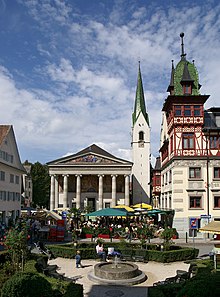Martin from Kink


Martin Ritter von Kink (born November 11, 1800 in Innsbruck , † November 7, 1877 in Vienna ) was an Austrian technician (kuk Oberbaurat) and industrialist.
Life and work
In 1819 he was a construction trainee, in 1824 a road builder in Pustertal .
He held the office of district engineer in Vorarlberg and in 1840 wrote a drainage plan for the lower Vorarlberg Rhine Valley with the idea of what is now the Vorarlberg Rhine Valley Inner Canal .
At the age of 48 he held the office of regional building director in Innsbruck , in 1853 he took over the office of senior building officer and regional building director at the Styrian Lieutenancy in Graz , before retiring in 1869.
In the same year he took over the Kufstein cement factory from the childless widow of his nephew Anton Kink and carried out large deliveries for the construction of the northern railway , the first Viennese spring water pipeline and the Vienna city hall . His brother Franz Kink is considered to be the founder of the cement industry in the Austrian Empire .
After the factory was sold to Perlmooser AG in 1872 , he and his sons and sons-in-law acquired the liquidated Heinrichsthaler paper mill in Moravia in 1875 . Since the production of rag paper was not worthwhile in this wood-rich area of the Jeseníky Mountains , he switched to the production of wood paper , built four wood grinding shops and a gray cardboard factory and carried out a technical redesign of the old facilities.
He is buried in the St. Leonhard Cemetery in Graz .
His son, Julius Ritter von Kink (1848–1909) became a member of the House of Representatives and the Manor and President of the Vienna Chamber of Commerce and Industry .
Act
As a construction technician, Kink made a particular contribution to the torrent control .
In 1858 he wrote a project for a Danube breakthrough near Vienna , which was later carried out with minor changes, and in the same year he was awarded the fourth prize for his project for the expansion of the city of Vienna . He played a decisive role in regulating the Rhine and carried out the expansion of the inner city of Graz . Kink, according to whose plans the work on the Adige river regulation began in 1869 , which had as a novelty the construction of the side embankments at high water level, was raised to the nobility in 1869 because of his services to the hydraulic engineering , whereby he renounced the title "von Kronbichl".
In 1934 the Kinkplatz in Vienna- Penzing (14th district) was named after him. In Klagenfurt the street at the foot of the Kreuzbergl, east to south of the Kreuzbergkirche is called Kinkstraße. In Graz , Kinkgasse runs across from Volksgartenstraße across from Volksgarten. There are four Kinkweg trails in Styria - in Oedt near Feldbach , in Bärnbach , in Tobisegg and in Maria Lankowitz .
Works
- Kaiser Franz-Josef facilities on Kreuzbergl in Klagenfurt , Carinthia
- Parish Church Dornbirn-St. Martin (1839–1840) in Dornbirn , Vorarlberg
literature
- Constantin von Wurzbach : Kink, M. . In: Biographisches Lexikon des Kaiserthums Oesterreich . 11th part. Kaiserlich-Königliche Hof- und Staatsdruckerei, Vienna 1864, p. 274 ( digitized version ).
- Kink Martin from. In: Austrian Biographical Lexicon 1815–1950 (ÖBL). Volume 3, Publishing House of the Austrian Academy of Sciences, Vienna 1965, p. 333 f. (Direct links on p. 333 , p. 334 ).
| personal data | |
|---|---|
| SURNAME | Kink, Martin of |
| ALTERNATIVE NAMES | Kink, Martin; Kink, Martin Ritter von |
| BRIEF DESCRIPTION | Austrian construction technician |
| DATE OF BIRTH | November 11, 1800 |
| PLACE OF BIRTH | innsbruck |
| DATE OF DEATH | November 7, 1877 |
| Place of death | Vienna |